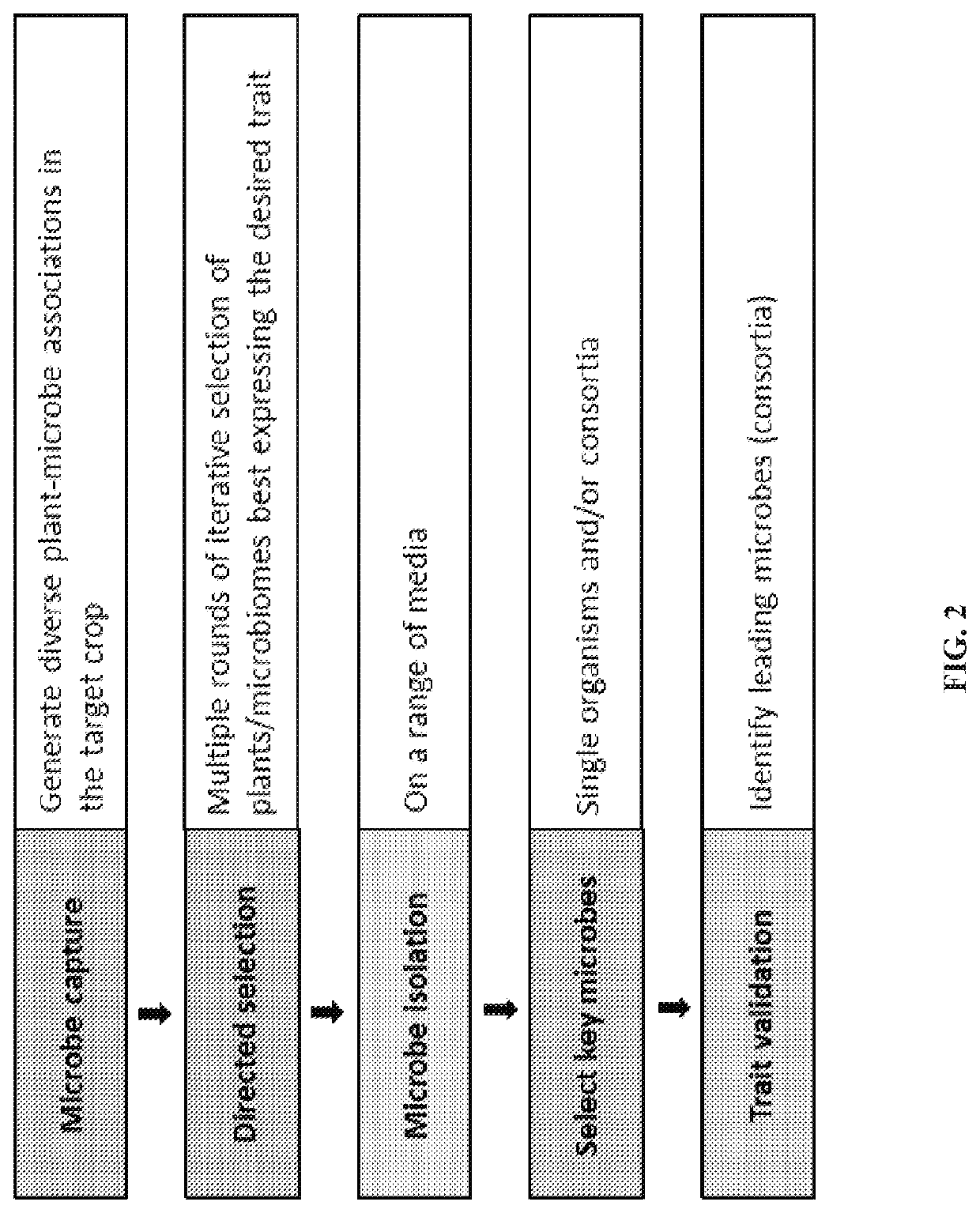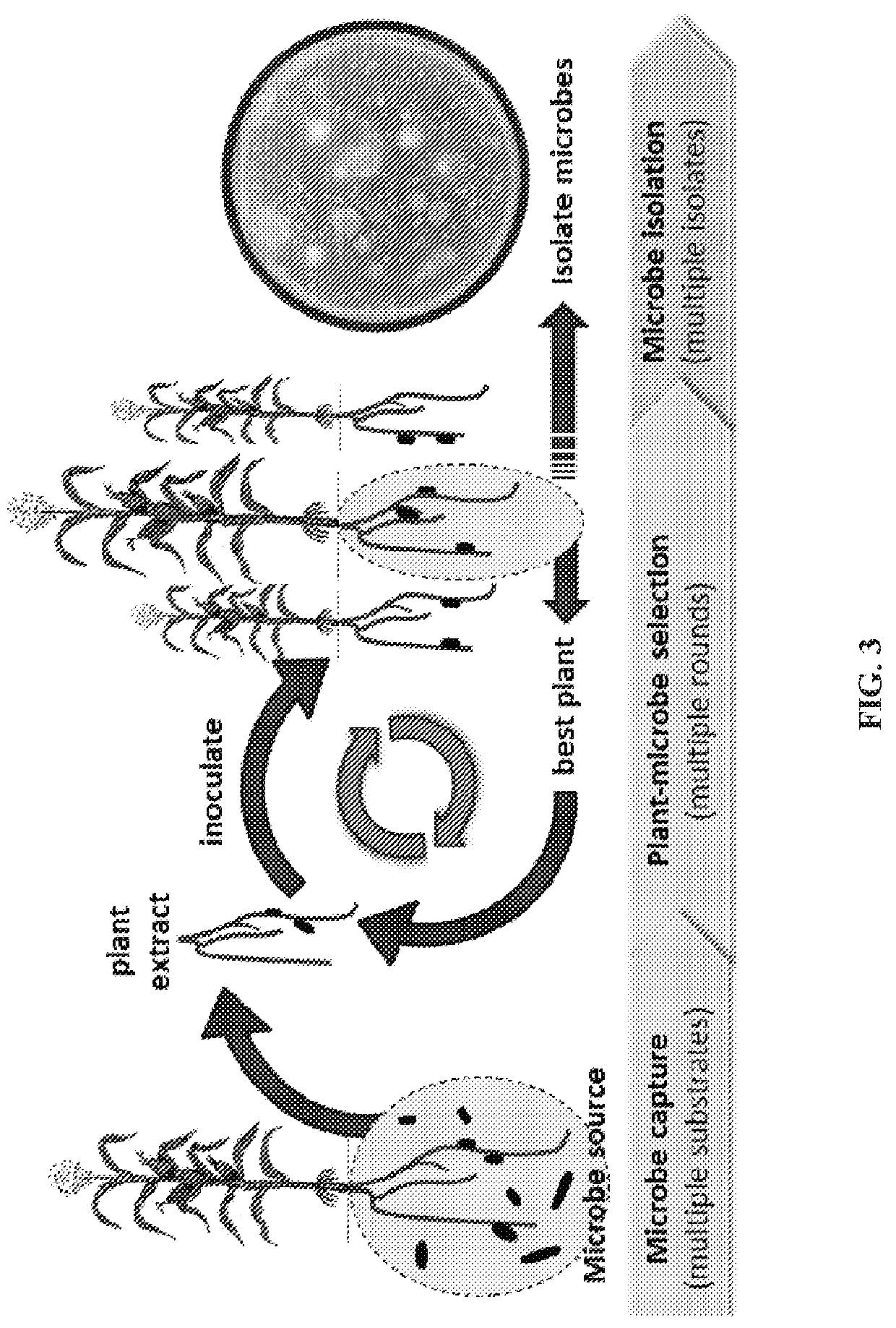Agriculturally beneficial microbes, microbial compositions, and consortia
a technology of microbial composition and beneficial microorganisms, applied in the field of isolated and biologically pure microorganisms, can solve the problems of difficult to achieve higher yields across a heterogenous worldwide landscape, shortening the food available to feed a growing world population, and reducing the number of cultivated species, so as to close the worldwide yield gap and improve crop performan
- Summary
- Abstract
- Description
- Claims
- Application Information
AI Technical Summary
Benefits of technology
Problems solved by technology
Method used
Image
Examples
example 1
Evaluation of Phenotype of Plants Exposed to Microbial Consortia in U.S. Trials
[0626]Plants disclosed in Table 20 were grown in a controlled environment in a rooting volume of 167 ml and typically in a soil substrate. The chamber photoperiod was set to 16 hours for all experiments on all species. The light intensity ranged from 180 μmol PAR m−2 s−1 to approximately 200 μmol PAR m−2 s−1 as plant height increased during experiments.
[0627]The air temperature was typically 28° C. during the photoperiod, decreasing to 23° C. during the night for Zea mays, Glycine max, and Sorghum bicolor experiments. Air temperature was typically 24° C. during the photoperiod, decreasing to 20° C. during the night for Triticum aestivum experiments.
[0628]Phenotypes were measured during early vegetative growth, typically before the V3 developmental stage.
[0629]Leaf chlorophyll content was measured midway along the youngest fully-expanded leaf, non-destructively using a meter providing an index of leaf chlo...
example 2
Evaluation of Phenotype of Plants Exposed to Microbial Consortia in New Zealand Trials
[0636]A. Seed Treatment with Microbial Consortia
[0637]The inoculants were prepared from isolates grown as spread plates on R2A incubated at 25° C. for 48 to 72 hours. Colonies were harvested by blending with sterile distilled water (SDW) which was then transferred into sterile containers. Serial dilutions of the harvested cells were plated and incubated at 25° C. for 24 hours to estimate the number of colony forming units (CFU) in each suspension. Dilutions were prepared using individual isolates or blends of isolates (consortia) to deliver ˜1×105 cfu / microbe / seed and seeds inoculated by either imbibition in the liquid suspension or by overtreatment with 5% vegetable gum and oil.
[0638]Seeds corresponding to the plants of table 21 were planted within 24 to 48 hours of treatment in agricultural soil, potting media or inert growing media. Plants were grown in small pots (28 mL to 200 mL) in either a c...
example 3
Evaluation of Yield Effect of Maize Exposed to Microbial Consortia in U.S. Field Trials
[0655]The data presented in Table 23 summarizes the changes in final yield relative to a control for six consortia tested in eight locations in the mid-West of the United States. Also presented is final yield data from two drought trials performed in California in the United States. Data is expressed as the percentage of trials in which a yield effect in bushels per acre of a particular magnitude was observed. All field trials were run in accordance with standard agronomic practices.
TABLE 23Field Trial Yield Increases (%)ConsortiaTrials>6 bu ac0-6 bu acD18 Yield62.52512.2D68 Yield252550D78 Yield2537.537.5D28 Yield2537.537.5D38 Yield252550D48 Yield2537.537.5D58 Yield255025D122 Drought100——
PUM
 Login to View More
Login to View More Abstract
Description
Claims
Application Information
 Login to View More
Login to View More - R&D
- Intellectual Property
- Life Sciences
- Materials
- Tech Scout
- Unparalleled Data Quality
- Higher Quality Content
- 60% Fewer Hallucinations
Browse by: Latest US Patents, China's latest patents, Technical Efficacy Thesaurus, Application Domain, Technology Topic, Popular Technical Reports.
© 2025 PatSnap. All rights reserved.Legal|Privacy policy|Modern Slavery Act Transparency Statement|Sitemap|About US| Contact US: help@patsnap.com



